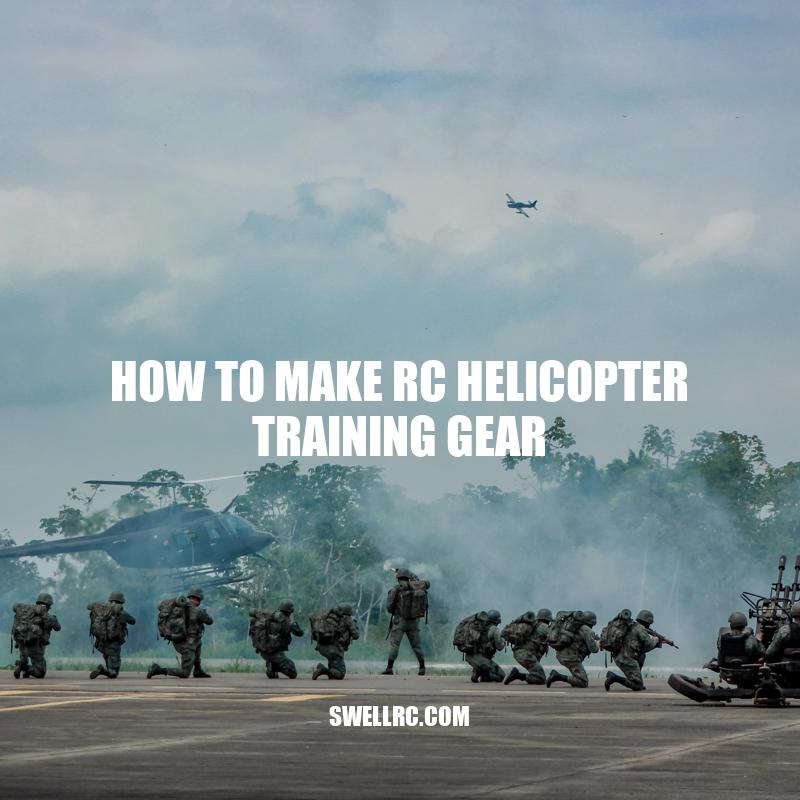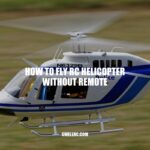DIY RC Helicopter Training Gear: Enhance Your Flying Experience
RC helicopters are a lot of fun to fly, but it takes time and practice to get the hang of controlling one. As a beginner, you’re probably going to have a difficult time mastering the basics of takeoff and landing without some assistance. Fortunately, you can make your own training gear to help you with the process. RC helicopter training gear, also known as landing gear, is an essential tool that helps beginners to stabilize their helicopters while learning the fundamentals of flying. Making training gear is easy and doesn’t require much in terms of equipment or skill. With a few simple steps, you can build your own, making it much easier and safer to learn or improve your flying skills. In this article, we’ll go over everything you need to know about how to make your own RC helicopter training gear.
Materials Required
To make an RC helicopter training gear, you’ll need some basic equipment that is readily available. Here are some of the materials that are required:
- Monofilament fishing line or thin wire
- Snap swivel
- Foam tubes
- Rubber bands
- Drill
- Pliers
You can buy these materials at a local hobby or craft store. If you are unsure about what to buy, you can also check online stores that sell RC helicopter parts and accessories. Make sure to get the exact materials you need as the wrong sizes may affect the efficiency of the training gear.
For RC helicopter parts and accessories, you can check out Horizon Hobby or Helifreak. They offer various options that fit different brands and models of RC helicopters.
Are RC helicopters hard to fly?
- RC helicopters can be difficult to fly, especially for beginners.
- The learning curve can be steep with complex controls and balance required.
- However, with practice and patience, anyone can learn to fly an RC helicopter.
If you’re interested in purchasing an RC helicopter, it’s recommended to start with a basic model and gradually work your way up. Some websites that offer a range of RC helicopters for beginners include:
Step-by-Step Process
Making an RC helicopter training gear is an easy process that can be done in a few simple steps. Here are the steps to follow:
| Steps | Instructions |
|---|---|
| Step 1 | Drill holes in the center of the foam tubes, about an inch apart. |
| Step 2 | Attach rubber bands through the holes and secure them firmly to one another to form a single loop. |
| Step 3 | Insert the monofilament wire or thin wire through the snap swivel, and tie a knot on the other end of the wire to prevent it from slipping out of the tube. |
| Step 4 | Run the other end of the wire through the center hole of the foam tubing. |
| Step 5 | Securely attach the gear onto the helicopter’s landing gear using the rubber bands. Ensure that the training gear is aligned and not tilted. |
Facts about RC Helicopter Training Gear
- The training gear is also known as “training wheels” or “training landing gear.”
- RC helicopter pilots use the gear to prevent their helicopters from tipping over during landing and takeoff.
- Training gear provides stability and keeps the helicopter grounded so that it doesn’t become uncontrollable.
- Some RC helicopter training gear is adjustable, providing more or less support depending on the flight skills of the pilot.
What is the gear ratio of RC helicopter?
The gear ratio of an RC helicopter is the number of teeth on the main rotor gear divided by the number of teeth on the pinion gear. This ratio determines the speed and power of the helicopter’s rotor blades. A higher gear ratio provides more power, but less speed, while a lower gear ratio provides more speed, but less power.
If you want to find out the gear ratio of your RC helicopter, you can check the specifications of your model or contact the manufacturer. Some websites that sell RC helicopter parts may also list the gear ratios of different models.
Choosing the Right Materials
To make a long-lasting and durable RC helicopter training gear, it’s important to choose the right materials. Here are some tips to help you choose:
- Use foam tubes that have a good diameter and can withstand the weight and force of the helicopter.
- Find a high-quality monofilament fishing line that can handle the weight of the helicopter without breaking.
- Choose a snap swivel that is sturdy enough to hold up to the weight of the wire and tubing.
- When looking for rubber bands, choose ones that are strong and stretchy, and will keep the foam tubing in place.
- You can find all the materials you need for RC helicopter training gear at your local hobby store or online.
- Have fun getting creative with colors and materials, so that your gear looks unique.
Conclusion
Congratulations! You have successfully made an RC helicopter training gear that is perfect for beginners. With this gear, you no longer have to worry about losing control of your helicopter during landing or takeoff. This simple DIY project can save you lots of money compared to purchasing pre-made training gear. Now you can confidently take your helicopter to the skies and practice your flying skills. Happy flying!
Adjusting the Gear
It may take a few attempts to get the gear just right, but it’s worth it to ensure stable and successful flights. Here are some tips for testing and adjusting your RC helicopter training gear:
- Try hovering the helicopter without the gear to get a sense of how it behaves.
- Attach the gear and lift off the ground, making sure the helicopter is level and not tilting in any direction.
- If the gear is causing the helicopter to tilt to one side, adjust the rubber bands to better balance the helicopter.
- If the gear is too loose or wobbly, tighten the rubber bands or adjust the foam tubing size.
- Pay close attention to how the helicopter reacts when using the gear during landing and takeoff and adjust as necessary.
- Practice and patience will go a long way in perfecting your gear.
Conclusion
Making your own RC helicopter training gear is an easy and fun way to improve your flying skills. With the aid of the training gear, beginners can achieve a smooth and stable flight, while also learning how to perform advanced flying techniques. Take your time to experiment and adjust the gear as needed to achieve the best possible results. You will soon become an expert in flying your RC helicopter!
Make sure to check out some of the best RC helicopters and helicopter products available on the market today. These products from top brands like Blade and Horizon Hobby can help take your flying experience to the next level.
How do you calculate the gear ratio of an RC helicopter?
To calculate the gear ratio of an RC helicopter, you need to follow these steps:
- Count the number of teeth on the main gear and the pinion gear.
- Divide the number of teeth on the main gear by the number of teeth on the pinion gear.
- The resulting number is the gear ratio of your RC helicopter.
It’s important to know the gear ratio of your RC helicopter as it affects the overall performance and speed of the helicopter. You can find more information and tools for calculating gear ratios on RC helicopter websites such as RC Groups or product pages for specific RC helicopter models on websites like Amazon.
Online Resources
In addition to making your own RC helicopter training gear, there are many online resources available to help you learn how to fly with confidence. Some useful websites and resources include:
- RC Groups – A comprehensive forum for RC hobbyists with a dedicated section for helicopter aerobatics and training.
- YouTube – A vast library of instructional videos on RC helicopter flying techniques, including beginner-level training.
- HeliFreak – A community of RC helicopter enthusiasts with a sub-forum dedicated to starting and improving in the hobby.
- FutabaRC – A beginner’s guide to flying RC helicopters, including tips on taking off, hovering, and landing.
- RC Airplane World – A general overview of RC helicopter flying, including how to choose the right aircraft and practice safe flying.
- Books – There are also several books available on Amazon that cover RC helicopter flying techniques and beginner-level training.
Conclusion
Whether you are a beginner or an experienced pilot, there are many resources available to help you improve your RC helicopter flying skills. By combining your own homemade training gear with the wealth of online resources available, you’ll be flying like a pro in no time. Take the time to practice and experiment with your helicopter and gear, and don’t be afraid to seek advice and help from the online community. Happy flying!
What materials are used to make a RC helicopter?
The materials used to make RC helicopters are typically lightweight and durable. The most common materials used are:
- Carbon fiber
- Aluminum
- Titanium
- Plastic
- Foam
The type of material used varies depending on the specific part of the helicopter. Carbon fiber is often used for the main rotor blades and body, while foam is used for the landing gear.
If you’re interested in purchasing an RC helicopter, websites such as Amazon and HobbyKing offer a wide range of products with detailed descriptions of the materials used.
Final Thoughts
In conclusion, RC helicopter training gear is a crucial tool for beginner pilots to master the fundamentals of flying safely and efficiently. Making your own gear is more practical than purchasing it, as it allows you to customize it to your specific helicopter and flying style. With the right materials and instructions, it’s easy to make your own training gear at home. By using the gear in combination with online resources and instructional videos, beginner pilots can accelerate their learning process and hone their skills.
Remember
Before taking off, make sure to double-check your equipment to ensure that everything is in good working order, and be sure to follow all safety guidelines when flying. And always be respectful of other pilots and their equipment when flying in a group.
Happy Flying
Flying RC helicopters can be a thrilling and rewarding hobby, and with the right training gear and resources, you’ll be able to take your skills to the next level. Take the time to practice and experiment with your gear and helicopter, and don’t hesitate to consult online resources and expert advice when needed. With patience, practice, and dedication, you’ll be soaring through the skies like a seasoned veteran in no time. Happy flying!



